The art of Devan Shimoyama (Philadelphia, 33) is defined by its femininity, and to understand that femininity, we need to go back to his childhood. The son of a young mother, Shimoyama grew up among women like his aunt, grandmother and great-grandmother, a true “matriarchal figure,” as the painter describes her on a phone call. These women inspired him, an only child, to engage in activities that would stimulate him “intellectually and creatively,” such as painting and drawing. It was during that time that Shimoyama developed a deep artistic curiosity.
His understanding of sexual minorities also comes from such childhood. At 5, his mother came out as a lesbian and started dating a woman who would later transition: an artist who inspired him and taught him figurative drawing. Growing up with a queer mother allowed him to explore his identity in a “safe space,” something reflected in an artwork that is “celebratory or joyous.”

In his portraits, Black people shine amid flashes of glitter in front of warm, red and orange backgrounds. This characteristic style led the young Shimoyama to have his first solo exhibition at the prestigious Andy Warhol Museum in Pittsburgh, Pennsylvania, in 2018. After that show, titled Cry, Baby, Shimoyama has traveled to New York, Chicago, and Germany. Currently, he is exhibiting at the Veta Gallery in Madrid (previously, he showed his Tarot paintings at the Contemporary Art Center of Malaga, a body of work focused on some practices like santería, which allows him to “explore a better understanding” of himself).
In Tarot, crystals and jewelry embellish the faces of his muses, resembling the cards of the mystical deck. Now, Shimoyama lives in Pittsburgh, where he is an Assistant Professor of Art at Carnegie Mellon University.
Question. Gems and glitter inspire your art. Where does this inspiration come from?
Answer. A lot of the materials I use include jewelry, which I associate with drag queens and drag culture. But I also associate it with a lot of the women that attended church growing up.
Q. What is the meaning of these shiny objects?
A. I think of it as a way for people to present a better version of themselves that feels brighter, shinier, perhaps more luxurious but on a dime. I love when people feel more luxurious just by wearing something shiny, something that when the light hits in the right way transforms not just themselves but also their environment.
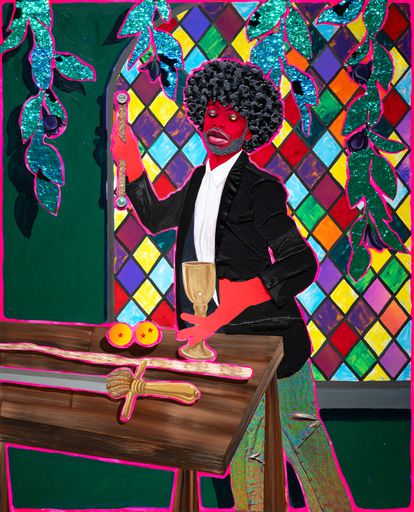
Q. You mentioned the influence of drag culture in your art, something that appears in paintings such as Miss Toto. How did drag end up at the center of your universe?
A. I had this real deep interest in drag culture in general. I started frequenting drag bars locally where I live and when visiting friends in other cities. I was really dazzled by that transformation, these big, constructed women that are fully creating a fantasy, adorning their bodies and changing character. It was really fascinating to think that these people are getting ready for five hours beforehand to perform two numbers that are six minutes, and for those six minutes they freeze time or extend time in a way that feels like magic.
Q. And what is your relationship with Miss Toto?
A. When I did this artist residency in Miami, I contacted Miss Toto and asked her if I could follow her around in some of her day-to-day activities when she is performing, when she is getting ready [and] with her drag family. And I got to know them very well and we are great friends to this day. I really felt like my work was doing something similar, maybe in a more passive way [since] I am not performing on stage. But I do think of the way in which I am dressing up the painting, and a lot of the materials I am using are very similar.

Q. Women at church, you said, have greatly inspired your work. What is your current relationship with religion?
A. I grew up going to a Baptist Christian Church that I still go when I visit family back home in Philadelphia. I still like to think of myself as someone who is defined by an upbringing in Christianity — that is not to say that I would tell somebody that I am Christian necessarily. But I do think that it did a lot for me in terms of building character and morality. And it also did a lot of things that are really complicated and difficult. However, I was really fortunate: my church was a quite welcoming space. I just think that a lot of the discourse around Christianity makes for a very complicated embracing of that as a queer identifying person. I never felt like I was able to fully explore things that felt interesting or exciting to me.
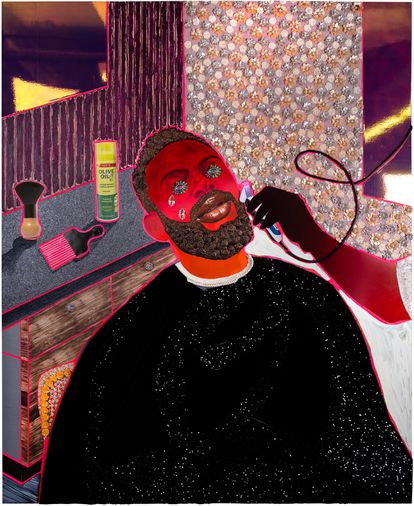
Q. Queer themes are present throughout your art, especially its relationship with masculinity. In paintings such as Not Too Close, you portray men shedding tears made of glass while getting a haircut at the barber shop. What ideas lie behind this queer masculinity?
A. It was an attempt at confronting something that made me very uncomfortable both as a child and today. Hypermasculine spaces in which queerness or femininity is not welcomed feel incredibly uncomfortable to me. It was a way to reinvent that space as somewhere that could be more welcoming. Growing up, I really hated going into barber shops because I would see way that other boys were treated in that space, [how] their actions were monitored.
Q. These paintings somewhat reinvent the masculinity that used to oppress you.
A. The way I deal with hypermasculinity in my work is I fight against it a lot and I celebrate a more colorful, sparkly [art.]
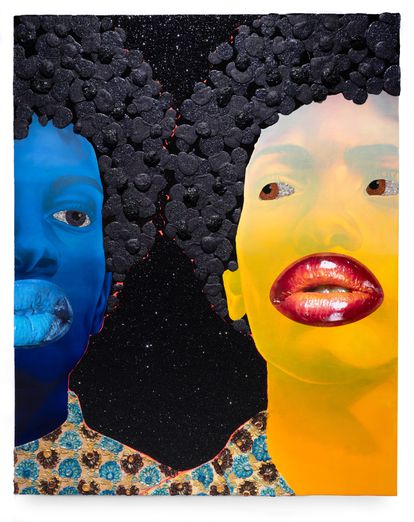
Q. And the big, glossy lips in paintings such as Self Portrait as Katrina, do they also represent a political message?
A. I did a residency in the south of France, and we had a little open house and some people were very confused as to why I would put such big lips on beautiful people. I was like: “Oh, I think that big lips are really beautiful.” It is both about exaggerating the fullness of the lips as a celebration of full-lip people, and I am one of those full-lip people, and also a celebration of women and giving voice to not just women but femininity. People need to lean more into their femininity.
Q. What is the relationship between your identity as a queer Black man and your artwork?
A. I think that Blackness and queerness should lift each other up, both being identities that are othered. Unfortunately, the ways in which Blackness and masculinity feel this desire to be something that should not intersect with queerness creates this point of tension. I have only painted Black people my entire career, and I think that is important, but the work is innately queer whether the people being represented identify that way. It is channeled through me, through my mind. I have a desire to put more Black queer bodies or queer representation into the canon.
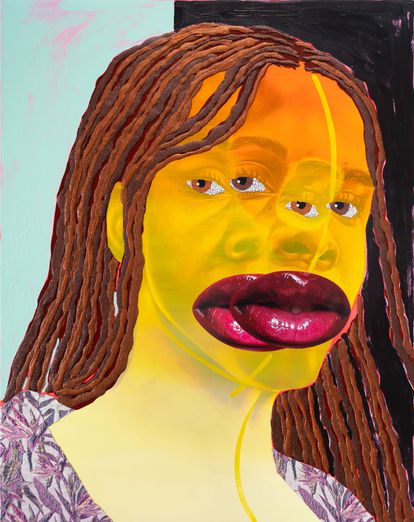
Q. Right now, several Black queer artists like Clifford Price King, Myles Loftin and Quil Lemons — who currently has an exhibition in New York — are receiving more artistic and media attention. Is the art world starting to reflect a diverse society?
A. It is starting to change a bit. I have also noticed what you are describing, this rise of Black artists, Black queer artists, Black women artists really getting a lot of visibility. I do think it is still disproportionally low. The thing that would help push that a little bit further would be if there were more Black curators, Black gallerists [and] Black collectors. Artists are a lot of times the face of the operation, but I think a lot of the inner workings in the behind the scenes and also on the market side of things it is still very white, very wealthy, very straight.
Q. What do you think has changed in your art after your first solo exhibit in 2018, when the country was still governed by Trump?
A. During the 2016 election, my work pivoted to be more directly responsive to things like the Black Lives Matter movement and the George Floyd riots. Making work that felt very intentionally Black, very intentionally queer that resisted against what people felt what America represents was really important to me. All those things are a part of my practice, but I did not want to be pigeonholed. I just want to follow a curious idea, a whim that I might have, just like any other artist that does not have to wrangle with their identity all the time.
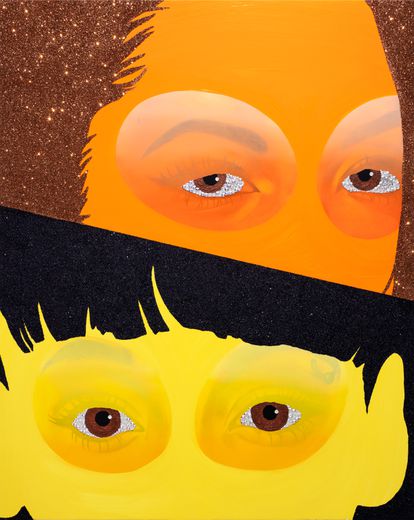
Q. How do you see yourself in the future, how do you think your art is going to evolve?
A. I am thinking a lot about giving myself a little bit more time to work on a body of work that maybe indulges in some of my personal interests. I would really like to invest a little bit more deeply in building a more detailed and nuanced world that I can then create works within. An opportunity to have a structure within that I can explore various ideas that are a little different from what I have been doing previously.
Sign up for our weekly newsletter to get more English-language news coverage from EL PAÍS USA Edition
This post was originally published on this site be sure to check out more of their content.







